Sheerin--Zhao Method
From Superliminal Wiki
Contents
Sheerin-Zhao Method (Hybrid) V1
This method is an attempt to make a 4D analogue of the Fridrich/CFOP method. Using this method results in around 650 to 900 moves, even if no shortcut turns are used. This method needs significant improvement because of the move count required for the last layer.
Prerequisites
- Knowledge of how the cube rotates.
- The Fridrich Method (F2L/OLL/PLL). 2-look OLL/PLL is enough.
- Some commutators, especially the monoflip. (R' D' R D R' D R and its inverse)
- The notation described above
Summary of the Method
- Cross: Make a cross by solving 8 2C pieces on the far cell.
- F2L: Fill in F2L slots by joining F2L pairs (2C/3C) together and inserting them into their respective slots.
- S2L: Fill in S2L slots. This is done by moving a 3C piece and its respective 4C piece onto the farthest cell. Then, OLL algorithms are used to orient the pieces so that they can be joined using RKT moves. They are then inserted using modified RKT moves.
- OLL: Orient the LL 2C pieces, 3C pieces, then the 4C pieces using OLL-C (corner OLL) algorithms, such as the sune/antisune. Try to get as many corners oriented as possible as well. Setup moves are highly recommended here.
- Pre-PLL: Permute the 2C of the LL using U-perms.
- PLL: Solve the LL like a 3^3 by using RKT moves. (The cube is rotated at this stage)
- Parity: If the "top face" of the LL is 180 degrees off from the rest of the puzzle, use the RKT variant of the 180-degree-CW supercube center algorithm (R U R' U five times, OR L R U2 R' L' U twice).
Method
Cross
- Pick the colour that you will be using for the near cell (the cell not inside the viewpoint). In this example, cyan is chosen.
- Rotate the puzzle so that the cell with that specified colour is now the near cell.
- Intuitively place all -K (2C face) pieces oriented and permuted correctly.
This image shows the solved cross.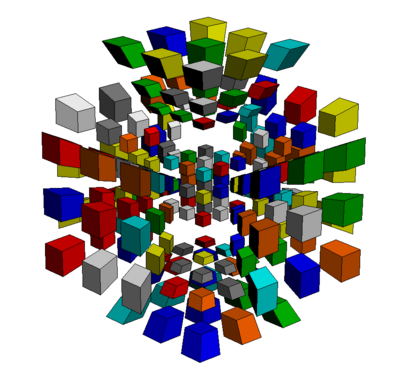
F2L
- Find any 2C piece that does not include a sticker with the colour of the far cell (i.e. grey).
- Find the 3C piece with the stickers that have the same colours of the 2C piece and of the near cell. For example, if the 2C piece's colours were red and yellow and the near cell piece was cyan, the 3C piece would be red, yellow, and cyan.
- Intuitively align the two pieces so that they lie on the same slice on the far cell.
- Join the pair together and insert the pair into the slot using -U moves.
- Repeat 11 more times.
Note: It is possible to insert the slot flipped. There are many shortcuts in forming pairs too. The image below shows the flipped pair (white-blue).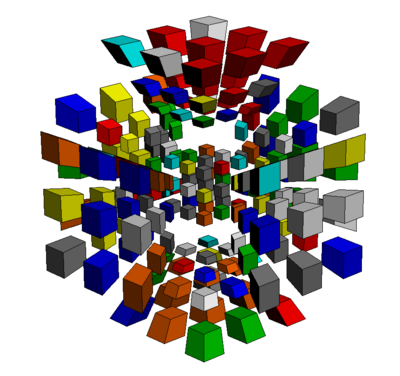
- Here is what it should look like when you are done:
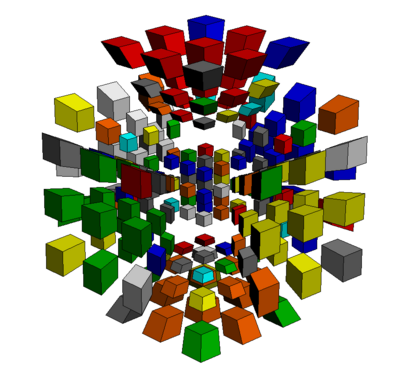
S2L
- Find any 3C piece that does not include a sticker with the colour of the far cell (i.e. grey).
- Find its respective 4C piece (see F2L for details).
note: try finding pairs that are already on the far cell first. - If either piece is already inserted and there are no more pairs on the far cell, go down to step 6 and use the algorithm to take the piece out of the slot.
- Orient the pieces so that the same colours are on the far cell. Sune and antisune is used. Setup moves and RKT are a must.
- Join the pair together using RKT moves. Twist the far cell until the pair is aligned as shown below (i.e. the green-orange-white pair on the D cell):

It is possible for the pair to be oriented in two other ways. Make sure that the side colours of the S2L pair match the colours of the faces. Notice how the green and orange stickers match up with the side. - Now, the piece can be inserted using RKT. In this case, it is in the form of RU and D- instead of RK and T-, since you are treating the D cell as a 3^3. In the example shown above, since it is to the left of the slot from that viewpoint, it can be inserted using: (LU DT LU' DT') (LU' DT LU DT'). The next image shows the pair in place.
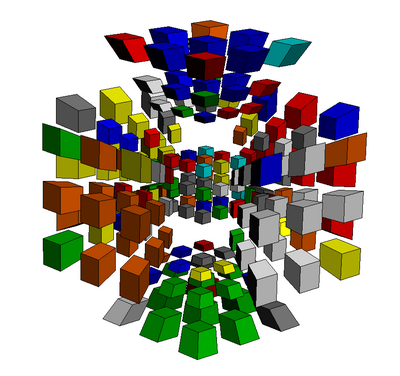
- Repeat 7 more times.
- Here is what it should look like when you are done (By now you should have used at most 450 moves):
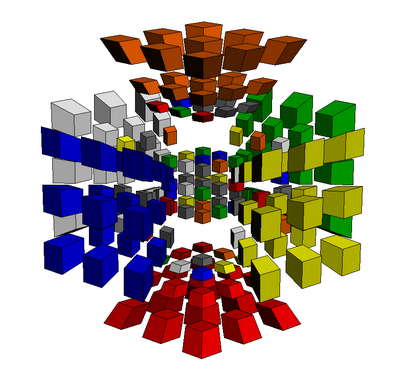
OLL
- Use -U variants of OLL algorithms to orient the 2C pieces. (e.g. for line, FU RU TU RU' TU' FU')
Attempt to orient as many 3C pieces in this step as possible. - For any unoriented 3C pieces, orient them using -U variants of corner OLL algorithms such as the sune.
Note: if there is only one 3c piece left unoriented (see image below), place it so that it's facing you (see f2l flipped pair pic for reference).
Use this algorithm if the piece needs to rotate CW: [RK2 RU' TR2 TU' LT2 LU' TR2 TU']*2. For rotating the other way, just reverse the algorithm.
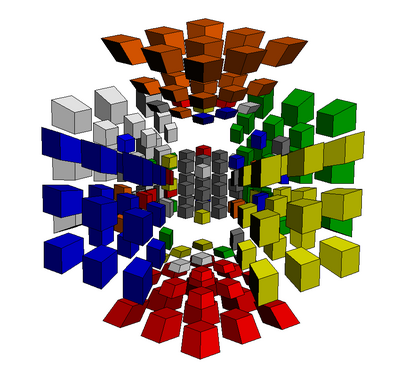
- Before starting to orient the 4C pieces, rotate the cube so that the up cell is now the far cell (T->U). The next image shows the transformation. (Notice the unoriented 3C piece. That is an error; orient all 3C pieces first!)
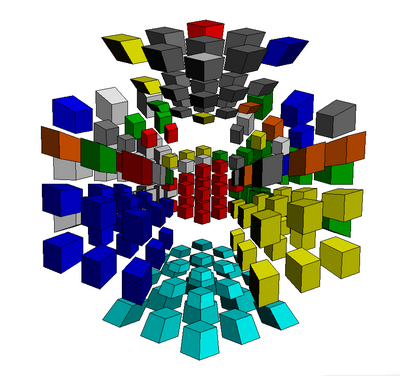
- Do U- moves so that the unoriented 4C pieces have their U cell sticker (i.e. grey sticker) NOT on the T cell.
- Use RKT variants of corner OLL algorithms to orient the 4C piece. If by the end of the algorithm the right cell isn't aligned with the rest of the puzzle, do TF, turn RK until the right slice realigns, then do TF'. Repeat this step and the previous one until all 4C pieces are oriented.
- If there is only one 4C piece left unoriented (see image below), place it so that it's facing you (see f2l flipped pair pic for reference).

Then, do BR', use the RKT variant of the monoflip, and do BR. The monoflip to rotate the U-layer sticker of the FULT piece from the L cell to the U cell is as shown: [R U R' U']*2 L' [U R U' R']*2 L. Do the inverse for the algorithm that rotates the U-layer sticker of the FULT piece from the F cell to the U cell. - When all LL layer pieces have been oriented, the T cell should be one uniform colour. Rotate the puzzle back (U->T). The image below shows the unrotated puzzle.
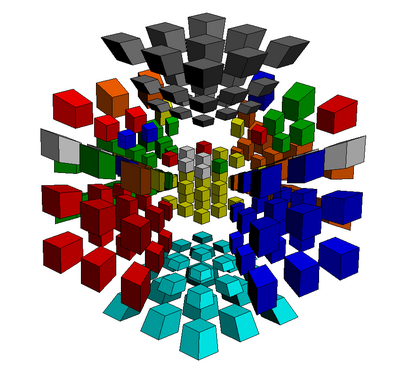
PLL
- Do T- moves to match as many 2C pieces as possible (At least 2). Then use the -U variant of the U perms to match the rest. (See the first step of OLL for an example of a -U variant.)

- From here, you use RKT moves to solve the rest of the puzzle like a 3^3. Parity: If the "top face" of the LL is 180 degrees off from the rest of the puzzle, use the RKT variant of the 180-degree-CW supercube center algorithm (R U R' U five times, OR L R U2 R' L' U twice).
Please note that this step is very inefficient and can take up to 200 moves on its own.